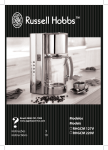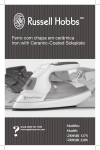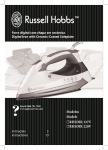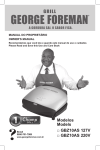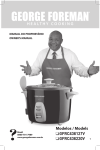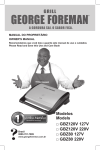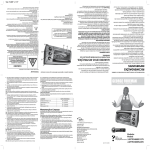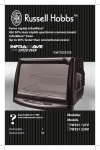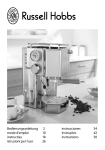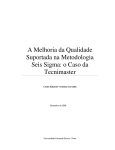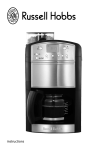Download Modelos Models RHGES 127V RHGES 220V
Transcript
TM Brasil: 0800-701-7989 www.applicaservice.com instruções instructions 3 13 Modelos Models ❑RHGES 127V ❑RHGES 220V medidas de precaução importantes Siga as precauções básicas de segurança, incluindo as seguintes: 1 Este aparelho só deve ser utilizado por um adulto ou sob a vigilância de um adulto responsável. Utilize e guarde o aparelho fora do alcance das crianças. 2 Tenha cuidado. Este aparelho utiliza vapor sob pressão. 3 Não deixe o aparelho desacompanhado enquanto estiver ligado. 4 Não mergulhe o aparelho em líquidos, nem o utilize em casas de banho, próximo de água ou ao ar livre. 5 Não toque em superfícies quentes (como, por exemplo, o filtro, o porta-filtro ou o tubo de vapor). 6 O risco de queimaduras dura bastante tempo depois da fervura. Mantenha o aparelho e o cabo eléctrico afastado das bordas das bancadas e fora do alcance das crianças. 7 Ao utilizar o bico de vapor, mantenha os dedos afastados do vapor. 8Utilize apenas água fresca, limpa e fria. Não encha o depósito com leite ou qualquer outro líquido. 9 Coloque o aparelho numa superfície estável, nivelada e resistente ao calor. 10 Estenda o cabo eléctrico de forma a não ficar suspenso, trilhado ou onde se possa tropeçar. 11 Este aparelho não deverá ser posto em funcionamento com um temporizador externo ou com um sistema de comando à distância. 12 Desligue o aparelho da tomada quando não estiver a ser utilizado, antes de o deslocar ou de o limpar. 13 Coloque o aparelho e o cabo eléctrico afastados de placas ou cabeças de fogões eléctricos ou a gás. 14 Não instale acessórios que não sejam fornecidos por nós. 15 Não utilize a máquina para quaisquer outras finalidades senão as descritas nestas instruções. 16 Não utilize o aparelho se estiver danificado ou defeituoso. 17 Se o cabo eléctrico estiver danificado, o fabricante, o seu agente de assistência técnica ou qualquer profissional devidamente qualificado deverá substituí-lo para se evitarem riscos. apenas para uso doméstico antes de utilizar pela primeira vez 1 Encha o depósito, e ponha a máquina a funcionar sem café. 2 Deixe arrefecer, deite a água fora e use a máquina normalmente. água engarrafada 3 Se utilizar água engarrafada, certifique-se de que não contém quaisquer ingredientes adicionados, como sabores, etc., e use água sem gás. O dióxido de carbono que se usa para dar “gás” às águas afectará negativamente o sabor do café. instruções Leia atentamente todas as instruções e guarde-as num local seguro. Se der ou emprestar o aparelho a alguém, entregue também as instruções. Retire todo o material de embalagem, mas guarde-o até verificar que o aparelho funciona. preparação carregar 4 Coloque o aparelho numa superfície estável, nivelada e resistente ao calor. 5 Estenda o cabo eléctrico de forma a não ficar suspenso, trilhado ou onde se possa tropeçar. 6 Não o ligue à tomada ainda. 20Alinhe o manípulo do porta-filtro com a seta esquerda ) na parte frontal da máquina. 21Os pinos na parte superior do porta-filtro devem encaixar nos pinos à volta da cabeça. 22Gire o manípulo com a seta direita ) na parte direita da máquina, para fixar o portafiltro no seu sítio. ,As marcas podem não coincidir exactamente: gire o manípulo para a direita até onde puder ir confortavelmente. Não o force. enchimento do depósito 7 Retire o depósito do lado do aparelho. 8Encha o depósito com água. Não o encha até cima. Assim evitará entornar água pelo caminho de volta para o aparelho. 9 Volte a colocar o depósito no lado do aparelho. , Pressione firmemente a parte inferior do depósito, para se certificar de que a válvula fica aberta e de que a água pode fluir para o aquecedor. purgar a bomba 10 Para retirar bolhas de ar, o aparelho deve ser purgado fazendo correr água e vapor pelo sistema. a) Purgue antes de utilizar, depois de voltar a colocar o depósito de água, se o depósito tiver ficado vazio ou se o aparelho esteve sem ser utilizado durante mais de uma hora. b)Coloque um recipiente termo-resistente debaixo da cabeça para recolher a água. c) Ligue a ficha à tomada eléctrica. d)Pressione e solte o botão 3. e) A luz 3 acender-se-á e manter-se-á acesa enquanto o aparelho estiver ligado à corrente. f) Pressione e solte o botão [. g)Começará a sair água da cabeça. h)Deixe-a correr até o recipiente estar meio cheio. i) Pressione e solte o botão [, para parar a bomba. j) A máquina foi purgada e está pronta para fazer café. Deite fora a água dos recipientes. k) Verifique o nível de água no depósito e encha-o se for necessário. enchimento de café 11 Para uma chávena de café, use o filtro pequeno, para duas chávenas, use o filtro grande. 12 Encha o filtro até à borda. 13 Prense o café com o prensador. 14 O café deve estar bem prensado, mas não compactado. 15 Coloque o filtro no porta-filtro e empurre-o para baixo a fim de o fixar na posição adequada. 16 Limpe os restos de café da borda, ou o porta-filtro não entrará correctamente na cabeça. monodoses 17 Coloque uma monodose no filtro para monodoses. 18 Verifique que o friso nas bordas da monodose está completamente dentro do filtro. 19 Coloque o filtro no porta-filtro e empurre-o para baixo a fim de o fixar na posição adequada. tirar café expresso 23Coloque uma ou duas chávenas na cobertura do tabuleiro recolhe-gotas. Para uma chávena coloque-a debaixo de ambas as saídas. Para duas chávenas coloque uma chávena debaixo de cada uma das saídas. 24Ligue a ficha à tomada eléctrica. 25Pressione e solte o botão 3. 26A luz 3 acender-se-á e manter-se-á acesa enquanto o aparelho estiver ligado à corrente. 27A caldeira começa a aquecer. 28Quando o indicador luminoso [ está aceso, significa que o aparelho está pronto para fazer café expresso. 29A luz [ acender-se-á e apagar-se-á ciclicamente, à medida que o termóstato vai funcionando para manter a temperatura. 30Espere até que o indicador luminoso [ esteja aceso. 31Pressione e solte o botão [. 32Ouvirá a bomba em funcionamento, e o café sairá das saídas. 33Esteja com atenção ao nível das chávenas. 34Pressione e solte o botão [, para parar a bomba. * Pare a bomba antes de as chávenas estarem cheias até ao nível desejado (25-30 ml), porque o líquido que já está dentro do filtro ainda terá que sair. 35O indicador luminoso adjacente ao botão desliga-se. 36Se estiver a fazer cappuccino, consulte a secção “cappuccino” na página 6. mais? 37A parte de cima da máquina ficará quente. Se for tirar mais cafés, pode utilizar esta superfície para aquecer as chávenas. 38Ponha uma mão na parte lateral da máquina para a segurar. 39Segure o cabo do porta-filtro com a outra mão, rode o cabo para a sua esquerda, e puxe-o para baixo para o retirar da câmara de infusão. 40Despeje os resíduos de café do filtro. 41Deixe arrefecer o filtro e o porta-filtro e retire o filtro do porta-filtro. 42Lave o filtro e o porta-filtro com água fria e clara. 43Verifique o nível de água no depósito e encha-o se for necessário. 44Volte para o ponto 11 e encha o filtro com café. já acabou? 45Pressione e solte o botão 3. 46Desligue a máquina, deixe-a arrefecer e limpe-a (consulte “cuidado e manutenção”). cappuccino 47O cappuccino é um café expresso com uma cobertura de leite espumoso. 48Precisa de uma caneca ou de um jarrinho com leite frio e uma chávena para recolher os salpicos. 49Para deixar espaço para a espuma não encha a caneca com mais de dois terços. 50Em princípio, a caneca deve ser alta e estreita, já que o leite deve ter uma altura que permita cobrir a ponta do bico de vapor sem que este tenha que atingir o fundo da caneca. 51Descobrimos que o leite semi-desnatado dá melhores resultados do que o leite gordo. Experimente diferentes tipos para ver qual é o que resulta melhor na sua área. 52Não tente fazer demasiada espuma de uma vez. Demasiado vapor deixará de criar espuma e ficará só com o leite quente e aguado. preparar a espuma 53Para obter os melhores resultados, faça a espuma depois de ter tirado o café, enquanto a máquina ainda estiver quente. 54Vire o bico de vapor para fora, para que não esteja por cima do tabuleiro recolhegotas. 55Coloque a caneca com o leite no bico de vapor, de forma que a extremidade do bico de vapor se encontre imediatamente por baixo da superfície do leite. cuidado Para evitar o risco de queimaduras, mantenha os dedos, etc., afastados do vapor. 56Pressione e solte o botão S. 57O luz [ desliga-se. 58O termómetro mostrará que a temperatura está a subir. Quando chegar à temperatura de vapor, a luz S acender-se-á. 59Espere até que o indicador luminoso S esteja aceso. 60Gire gradualmente o controlo de vapor no sentido contrário ao dos ponteiros do relógio (S). 61Mova ligeiramente a caneca para cima e para baixo, mantendo sempre a extremidade do bico de vapor imediatamente por baixo da superfície do leite. 62Não deixe que a extremidade do bico de vapor saia do leite, ou salpicará. 63Continue até ter a espuma necessária. 64Gire completamente o controlo de vapor no sentido dos ponteiros do relógio para o fechar (S). 65Pressione e solte o botão S. 66Coloque outra vez o bico de vapor por cima do tabuleiro recolhe-gotas, já que vai ficar a pingar. 67Para fazer um cappuccino, coloque umas colheradas de espuma em cima da(s) chávena(s) de café expresso. limpar o bico de vapor 68Deve limpar o bico de vapor e o tubo imediatamente após a sua utilização, para evitar a solidificação de depósitos de leite, que poderiam bloquear o tubo e o bico. Além disso, é pouco higiénico. 69Coloque uma chávena debaixo do bico de vapor de forma que a extremidade se encontre bem dentro da chávena. 70Gire gradualmente o controlo de vapor no sentido contrário ao dos ponteiros do relógio (S). 71Deixe passar algum vapor para eliminar quaisquer restos de leite do interior do bico de vapor. 72Gire completamente o controlo de vapor no sentido dos ponteiros do relógio para o fechar (S). mais? ,Se quiser fazer mais café depois de ter utilizado o bico de vapor, tem que esperar até que a temperatura desça e a luz [ se volte a acender. 73Se tentar tirar um café à temperatura utilizada para fazer vapor, escaldará o café, o que lhe estraga o sabor. Tenha paciência e espere uns momentos. 74A máquina pode demorar 10 minutos a arrefecer, dependendo das condições locais. 75Se quiser apressar um bocadinho as coisas, pode usar a bomba para arrefecer a câmara de aquecimento. cuidado tenha muito cuidado, está a lidar com água muito quente e vapor. a) Verifique o nível de água no depósito e encha-o se for necessário. b)Coloque um recipiente termo-resistente de 300 ml debaixo da cabeça do aparelho para recolher a água. c) Pressione e solte o botão [. d)Começará a sair água da cabeça. e) Deixe correr a água até o ponteiro do termómetro descer até à marca 100 (cerca de 40 segundos / 250 ml de água). f) Pressione e solte o botão [, para parar a bomba. g)Espere até à luz se apagar e voltar a acender (mais uns 20 segundos). h)Deite fora a água dos recipientes. i) Verifique o nível de água no depósito e encha-o se for necessário. j) Volte para o ponto 11 e encha o filtro com café. aquecer leite 76Para aquecer leite para o café, siga o processo de produção de espuma, mas submirja bem o bico de vapor no leite, para que a passagem das bolhas de vapor pelo leite o aqueça. Tenha cuidado com o leite. Se puser demasiado vapor, ficará aguado. água quente 77Se quiser utilizar a máquina para produzir água quente para chá ou para qualquer outra bebida, siga o processo para tirar café, mas retire o filtro, adaptador e selo do porta-filtro, para que a água quente saia directamente pelas saídas. cuidados e manutenção TERMO DE GARANTIA LIMITADA 1 Desligue a máquina da tomada antes de proceder à sua limpeza ou de a arrumar. 2 Ponha uma mão na parte lateral da máquina para a segurar. 3 Segure o cabo do porta-filtro com a outra mão, rode o cabo para a sua esquerda, e puxe-o para baixo para o retirar da câmara de infusão. 4 Despeje os resíduos de café do filtro. 5 Deixe arrefecer o filtro e o porta-filtro e retire o filtro do porta-filtro. 6 Retire a cobertura do tabuleiro recolhe-gotas. 7 Para retirar o tabuleiro recolhe-gotas da máquina, levante-o. 8Limpe as superfícies exteriores do aparelho com um pano húmido. 9 Lave as peças amovíveis em água tépida com sabão, enxagúe bem e seque. 10 Volte a colocar o tabuleiro recolhe-gotas na parte inferior da máquina. 11 Volte a colocar a cobertura do tabuleiro recolhe-gotas. 12 Não lave quaisquer peças na máquina de lavar loiça. 13 O ambiente extremo dentro das máquinas de lavar louça pode afectar os acabamentos das superfícies. 14 Não mergulhe a máquina em água ou qualquer outro líquido. 15 Não utilize produtos ou solventes de limpeza abrasivos ou fortes. eliminação do calcário 16 A formação de calcário na resistência fará com que esta sobreaqueça, reduzindo a sua vida útil. Também aumentará o tempo de confecção do café. 17 Retire regularmente o calcário da resistência. Se reparar que a máquina demora mais tempo a preparar o café, aumente a frequência da operação. Em zonas com águas muito duras, pode ser necessário eliminar o calcário até uma vez por mês, ou usar água filtrada em vez de água da torneira. 18 Use uma marca de anti-calcário apta para ser utilizada em aparelhos plásticos. Siga as instruções da embalagem de anti-calcário. Quando tiver terminado, esvazie o jarro e ponha a máquina a funcionar umas duas vezes com água fresca, mas sem café. Elimine a água para se certificar de que não há resíduos químicos na máquina. ,Os produtos devolvidos durante a garantia com avarias devido a calcário estarão sujeitos a custos de reparação. Garantia: este produto, devidamente lacrado, é garantido pela Salton Brasil contra defeitos de material e mão-de-obra, pelo prazo total de um (1) ano a partir da data de Nota Fiscal de venda ao consumidor. Abrangência: a garantía do produto fica automaitcamente inválida se o produto for danificado em consequência de acidentes de transporte ou manuseio, uso inapropriado, descuido, negligência, serviços não autorizados, uso comercial, reparos providos por pessoas ou entidades não credenciadas, desgaste normal, adição de peças ou acessórios que não sejam de fábrica, danos de instalação ou outras causas que não as constatadas como sendo de fabricação. A presente garantia é aplicável somente para produtos adquiridos e utilizados no Brasil e não se estende a produtos que não tenham sido operados de acordo com as instruções de uso e operação especificasas no respectivo Manual do Proprietário fornecido pela Salton Brasil ou que tenham sido modificados ou peças danificadas que tenham tido o número de série removido, modificado, adulterado ou tornado ilegível. Grantias Implícitas: Esta garantia substitui todas as outras garantias expressas ou implícitas e nenhum representante ou terceiro está autorizado a assumir qualquer outra obrigação relacionada à venda de nossos produtos em nome da Salton Brasil. Execução da Garantía: durante o prazo de vigência da garantía, o produto defeituoso será reparado ou substituído por um modelo similar equivalente a novo (a critério exclusivo da Salton Brasil) quando for encaminhado à Assitência Técnica autorizada da Salton Brasil ou o valor referente ao preço de compra será devolvido. O produto reparado ou substituído terá garantia pelo prazo remanescente da garantia original do produto e mais um (1) mês adicional. Nenhuma taxa será cobrada pelo reparo ou substituição. Nas localidades onde não exita Assistência Técnica autorizada pelo Salton Brasil, as despesas de transporte do produto correm por conta do consumidor. Itens Excluidos desta Garantía: esta garantía substitui todas sa outras garantias expressas ou implicitas e nenhum representante ou terceiro está autorizado a assumir qualquer outra obrigação relacionada à venda de nossos produtos em nome de Salton Brasil. Sob hipótese alguma a Salton Brasil será responsável por defeitos, mau funcionamento ou deficiência do produto, seja baseado em lei contratual, comercial ou qualquer outra teoria legal, incluíndo, sem limitação, negligência, obrigação expressa, quebra da garantia e não cumprimento de cláusula contratual. A Salton Brasil não se responsabilizará por quaisquer danos diretos, indiretos, ou resultantes de uso ou desempenho do produto, ou outros prejuizos relativos a danos de propriedade, ou prejuízos pecuniarios. Assistência Técnica: Em caso de mau funcionamento entre em contato com o Serviço de Atendimento ao Consumidor Salton no número mencionado abaixo. Sporte e Serviço Russell Hobbs é uma marca da Salton, Inc. USA. Para mais informações sobre os produtos da Salton visite nosso site: www.saltonbrasil.com.br Salton Brasil Com. Imp. E Exp. De Produtos Eletro-Eletrônicos Ltda Av. Major Sylvio de Magalhães Padilha, 5200 Edifício Quebec, 8 andar - São Paulo - SP - CEP 05693-000 Todos os Direitos Reservados. NOTAS SAC: 0800-701 79 89 10 11 important safeguards Follow basic safety precautions, including: 1 This appliance must only be used by or under the supervision of a responsible adult. Use and store the appliance out of reach of children. 2 Take care – this appliance uses steam under pressure. 3 Do not leave the appliance unattended while plugged in. 4 Do not put the appliance in liquid, don’t use it in a bathroom, near water, or outdoors. 5 Do not touch hot surfaces (e.g. filter, filter holder, steam pipe). 6 The scald hazard lasts long after boiling. Keep the appliance and cable away from the edges of worktops and out of reach of children. 7 When using the frother, keep your fingers away from the steam. 8Use only clean, cold, fresh water, don’t fill the reservoir with milk or any other liquid. 9 Sit the appliance on a stable, level, heat-resistant surface. 10 Route the cable so it doesn’t overhang, and can’t be tripped over or caught. 11 This appliance must not be operated by an external timer or remote control system. 12 Unplug the appliance when not in use, before moving and before cleaning. 13 Keep the appliance and the cable away from hotplates, hobs or burners. 14 Do not use accessories or attachments other than those we supply. 15 Do not use the appliance for any purpose other than those described in these instructions. 16 Do not use the appliance if it’s damaged or malfunctions. 17 If the cable is damaged, it must be replaced by the manufacturer, its service agent, or someone similarly qualified, in order to avoid hazard. household use only before using for the first time 1 Fill the reservoir, and run the appliance without coffee. 2 Let it cool, discard the water, then use it normally. bottled water 3 If you use bottled water, check that there are no added ingredients, flavourings, etc., and use “flat” water, not “sparkling”. The carbon dioxide which gives the “sparkle” will adversely affect the flavour of your coffee. preparation 4 Sit the appliance on a stable, level, heat-resistant surface. 5 Route the cable so it doesn’t overhang, and can’t be tripped over or caught. 6 Do not plug it in yet. water fill 7 Pull the reservoir out of the side of the appliance. 8Fill the reservoir with water. Do not fill it to the top – you don’t want to spill water on the way back from the tap to the appliance. 9 Replace the reservoir in the side of the of the appliance. 12 13 instructions Read the instructions and keep them safe. If you pass the appliance on, pass on the instructions too. Remove all packaging, but keep it till you know the appliance works. ,Press the bottom of the reservoir firmly in, to ensure the valve is opened, and water can flow into the heater. prime the pump 10 To remove air pockets, the appliance must be primed by forcing water and steam through the system. a) Prime before use, after replacing the water tank, after refilling, if the tank has run dry, or if the appliance has been unused for over an hour. b)Put a heat-proof container under the brewing head to catch the water. c) Put the plug into the power socket. d)Press and release the 3 button. e) The 3 light will come on, and will remain on while the appliance is connected to the electricity supply. f) Press and release the [ button. g)Water will come out of the brewing head. h)Let it flow till the container is about half full. i) Press and release the [ button, to stop the pump. j) The machine has now been primed, and is ready to make coffee. Pour away the water in the container. k) Check the water level in the reservoir, and top up as necessary. coffee fill 11 For one espresso cup, use the small filter, for two cups, use the big filter. 12 Fill the filter to the rim. 13 Tamp the coffee down with the tamper. 14 It needs to be firmly tamped down, but not compacted. 15 Put the filter into the filter holder, and press it down, to lock it in place. 16 Clear any coffee grounds from the rim, otherwise it won’t seat properly in the brewing head. pods 17 Put a pod inside the pod filter. 18 Check that the frill round the edge of the pod is completely inside the filter. 19 Put the filter into the filter holder, and press it down, to lock it in place. loading 20Align the filter holder handle with the left arrow ) on the front of the appliance. 21The lugs on top of the filter holder should engage in the lugs round the brewing head. 22Turn the handle to the right arrow ) on the right side of the appliance, to lock the filter holder in place. ,The marks may not match exactly – turn the handle as far right as it’ll go comfortably, without straining. making espresso 23Put one or two cups on the drip tray cover, under the filter holder. For one cup, put it under both nozzles, for two cups, put one cup under each nozzle. 24Put the plug into the power socket. 25Press and release the 3 button. 14 26The 3 light will come on, and will remain on while the appliance is connected to the electricity supply. 27The boiler will start to heat up. 28When the [ light comes on, it’s ready to make espresso. 29The [ light will cycle on and off, as the thermostat operates to maintain the temperature. 30Wait till the [ light comes on. 31Press and release the [ button. 32You’ll hear the pump operating, and coffee will come out of the nozzles. 33Watch the level in the cup(s). 34Press and release the [ button, to stop the pump. ,Stop the pump just before the cups are filled to the level you want (25-30ml per shot), as the liquid trapped in the filter will still have to come out 35The light next to the button will go out. 36If you’re making cappuccino, go to “cappuccino” below. more? 37The top of the appliance will be hot. If you’re making more espresso, you could use the surface to warm the cups. 38Put a hand on the side of the appliance to steady it. 39Grip the filter holder handle with the other hand, turn the handle to your left, then lower it from the brewing head. 40Tip the coffee grounds out of the filter. 41Let the filter and filter holder cool, then prise the filter out of the filter holder. 42Clean the filter and filter holder with fresh, clean water. 43Check the water level in the reservoir, and top up as necessary. 44Go back to point 11, and fill the filter with coffee. finished? 45Press and release the 3 button. 46Unplug the appliance, let it cool down, then clean it (see “care and maintenance”). cappucino 47Cappuccino is espresso with a frothy milk top. 48You’ll need a mug or small jug containing cold milk, and a cup to collect drips. 49To allow room for the froth, don’t fill the mug more than two thirds full. 50Ideally, the mug should be tall and narrow, as the milk must be deep enough to cover the end of the frother without it hitting the bottom of the mug. 51We’ve found that semi-skimmed milk gives better results than whole milk. You’ll need to experiment to find which type works best for you in your area. 52Do not try to make too much froth at one time. Too much steam will flatten the milk, leaving you with nothing but hot, watery milk. frothing 53For best results, do the frothing straight after you have made your coffee, while the appliance is still hot. 54Swing the frother round so it’s clear of the drip tray. 15 55Bring the mug containing the milk up to the frother and hold it so that the end of the frother is just under the surface of the milk. caution to avoid the risk of scalding, keep fingers, etc. clear of the steam. 56Press and release the S button. 57The [ light will go out. 58The thermometer will show that the temperature is climbing. When it reaches steaming temperature, the S light will come on. 59Wait till the S light comes on. 60Gradually turn the steam control anti-clockwise (S). 61Move the jug up and down slightly, keeping the end of the frother just below the surface of the milk. 62Do not lift the end of the frother out of the milk, or it’ll spatter. 63Carry on till you have as much froth as you need. 64Turn the steam control fully clockwise to close it (S). 65Press and release the S button. 66Swing the frother back over the drip tray, as it will drip. 67To make cappuccino, spoon the froth on top of the cup(s) of espresso. clean the frother 68You must clean the frother, steam pipe, and nozzle immediately after use, to prevent milk deposits going hard, and blocking the steam pipe and nozzle. It’s also unhygienic. 69Hold a cup under the frother, so that the end of the frother is well inside the cup. 70Gradually turn the steam control anti-clockwise (S). 71Let a little steam through, to remove any milk from inside the frother. 72Turn the steam control fully clockwise to close it (S). more? ,If you want to make more coffee after using the frother, you’ll have to wait till the temperature drops and the [ light comes on again. 73If you try to make coffee at the temperature used for making steam, you’ll scald the coffee, and spoil the taste, so be patient. 74It might take 10 minutes to cool down. It depends on local conditions. 75If you want to speed things up a bit, you can use the pump to cool the heating chamber. caution take great care, you’re dealing with boiling water and steam. a) Check the water level in the reservoir, and top up as necessary. b)Put a 300ml heat-proof container under the brewing head to catch the water. c) Press and release the [ button. d)Water will come out of the brewing head. e) Let it flow till the needle on the thermometer comes down to the 100 mark (about 40 seconds/about 250ml water). f) Press and release the [ button, to stop the pump. g)Wait till the [ light goes out and comes on again (another 20 seconds or so). h)Pour away the water in the container. i) Check the water level in the reservoir, and top up as necessary. 16 j) Go back to point 11, and fill the filter with coffee. warming milk 76To warm milk for your coffee, follow the procedure for making froth, but immerse the frother in the milk, so the steam bubbles through the milk, warming it up. Watch the milk carefully. If you use too much steam, you’ll get watery milk. hot water 77If you want to use the appliance to generate hot water for tea, or any other drink, follow the procedure for making coffee, but take the filter out of the filter holder, so that pure hot water drips from the nozzles. care and maintenance 1 Unplug the appliance and let it cool down before cleaning or storing away. 2 Put a hand on the side of the appliance to steady it. 3 Grip the filter holder handle with the other hand, turn the handle to your left, then lower it from the brewing head. 4 Tip the coffee grounds out of the filter. 5 Let the filter and filter holder cool, then prise the filter out of the filter holder. 6 Lift the cover off the drip tray. 7 To remove the drip tray, lift it up. 8Clean the outside surfaces of the appliance with a damp cloth. 9 Wash the removable parts in warm soapy water, rinse well, and dry. 10 Replace the drip tray in the bottom of the appliance. 11 Replace the drip tray cover. 12 Do not wash any part of the appliance in a dishwasher. 13 The extreme environment inside the dishwasher can affect the surface finishes. 14 Do not put the appliance in water or any other liquid. 15 Do not use harsh or abrasive cleaning agents or solvents. descaling 16 Scale build-up will cause the element to overheat, reducing its working life. It will also lengthen the brewing time. 17 Descale regularly. If you notice the brewing time getting longer, shorten the time between descalings. In areas of very hard water it may be necessary to descale as often as once a month, or to use filtered water instead of ordinary tap water. 18 Use a proprietary brand of descaler suitable for use in plastic-bodied products. Follow the instructions on the package of descaler. When descaling has finished, empty the carafe and operate the coffee maker twice more with fresh water, but without coffee. Discard the water to ensure that no chemical residues are left in the coffee maker. ,Products returned under guarantee with faults due to scale will be subject to a repair charge. 17 NEED HELP? For service, repair or any questions regarding your appliance, call the appropriate 800 number on cover of this book. Please DO NOT return the product to the place of purchase. Also, please DO NOT mail product back to manufacturer, nor bring it to a service center. You may also want to consult the website listed on the cover of this manual. One-Year Limited Warranty (Applies only in the United States and Canada) What does it cover? • Any defect in material or workmanship provided; however, Applica’s liability will not exceed the purchase price of product. For how long? • One year after date of purchase. What will we do to help you? • Provide you with a reasonably similar replacement product that is either new or factory refurbished. How do you get service? • Save your receipt as proof of date of sale. • Visit the online service website at www.prodprotect.com/applica, or call toll-free 1-800-231-9786, for general warranty service. • If you need parts or accessories, please call 1-800-738-0245. What does your warranty not cover? • Damage from commercial use • Damage from misuse, abuse or neglect • Products that have been modified in any way • Products used or serviced outside the country of purchase • Glass parts and other accessory items that are packed with the unit • Shipping and handling costs associated with the replacement of the unit • Consequential or incidental damages (Please note, however, that some states do not allow the exclusion or limitation of consequential or incidental damages, so this limitation may not apply to you.) How does state law relate to this warranty? • This warranty gives you specific legal rights. You may also have other rights that vary from state to state or province to province. 18 NOTES 19 PRODUZIDO NA CHINA / MADE IN CHINA Código da data / Date Code ICNPJ: 39.373.782/0001-40 POR CONTA E ORDEM DE Salton Brasil Com. Imp/Exp. de Produtos Eletro Eletrônicos Ltda CNPJ: 05.753.154/0001-78 SAC: 0800 701 7989 Modelo/Model: RHGES 127V Voltagem/Voltage: 127V Modelo/Model: RHGES 220V Voltagem/Voltage: 220V 2008/3-31-124P/E 20 439-725 Importado por CISA Trading S.A.











